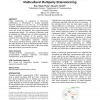Free Online Productivity Tools
i2Speak
i2Symbol
i2OCR
iTex2Img
iWeb2Print
iWeb2Shot
i2Type
iPdf2Split
iPdf2Merge
i2Bopomofo
i2Arabic
i2Style
i2Image
i2PDF
iLatex2Rtf
Sci2ools
CSCW
2010
ACM
2010
ACM
Groups in groups: conversational similarity in online multicultural multiparty brainstorming
Online collaboration, in comparison to face-to-face collaboration, is advantageous in making multiparty teamwork possible at a very low cost. As multicultural multiparty collaboration becomes ubiquitous, it is crucial to understand how communication processes are shaped in the social and media environments that computer-mediated communication affords. We conducted a laboratory study investigating how different types of cultural asymmetry in group composition (Chinese of the majority versus American of the majority) and communication media (textonly versus video-enabled chatroom) influence conversational similarity between Chinese and Americans. The paper presents an analysis identifying that the selection of media and the cultural composition of the group jointly shape intercultural conversational closeness. Author Keywords Computer-mediated communication, communication accommodation, multiparty teamwork, cross-cultural communication, group brainstorming ACM Classification Keywords H5...
Computer-mediated Communication Affords | CSCW 2010 | Keywords Computer-mediated Communication | Multicultural Multiparty Collaboration | Social Sciences |
| Added | 17 Mar 2010 |
| Updated | 17 Mar 2010 |
| Type | Conference |
| Year | 2010 |
| Where | CSCW |
| Authors | Hao-Chuan Wang, Susan R. Fussell |
Comments (0)

